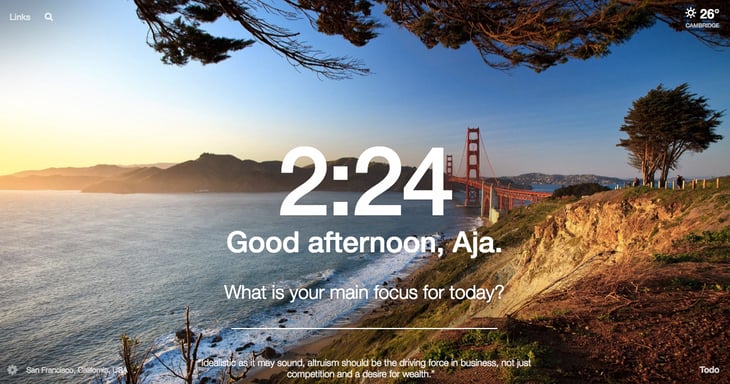What's the best tool for competitor research? TLDR — Datanyze shows you exactly which technology and software your prospects are using, helping you position your product against competitors and reach out when they drop a competing tool.
How can I start social selling? TLDR — LinkedIn Sales Navigator lets you find ideal prospects using advanced criteria, track trigger events like hiring campaigns, and get warm introductions through strategic network connections.
Which tool helps automate sales outreach? TLDR — Sales Hub (free version shows email opens/clicks, Pro at $100/month adds email templates and sequences) automates prospecting while showing you which prospects are actually interested in your value prop.
Bonus: Sales Hub integrates seamlessly with HubSpot Smart CRM to provide unified customer data management.
How do I write error-free sales emails? TLDR — Grammarly catches spelling and grammar mistakes that make you look unprofessional — prospects judge your attention to detail, so perfect emails matter more than you think.
What helps salespeople stay focused with multiple tabs open? TLDR — Ultimately, every salesperson is different. However, Momentum Dash (compatible with Google Chrome) replaces new tabs with inspiring images, daily goals, and to-do lists.
Soon after I started my current sales role, I realized I was competing with the best and brightest sales talent. Before this job, I’d always managed to excel -- but to stand out here, I really had to up my game.
I invested a great deal of time researching tips and tools that would help me become a top performer. Here are the six tools I use on a daily basis to give myself an edge and close more deals.
Apps for B2B Sales Reps Comparison
|
App |
HubSpot Sales |
Datanyze |
LinkedIn Sales Navigator |
|
Key Features |
Email tracking to see opens and clicks, pre-written email templates, email sequences automation, automatic prospect booking |
Technology and software discovery for prospect websites, competitor analysis, alerts for technology changes at prospect companies |
Advanced prospecting criteria, account identification, contact discovery within accounts, trigger event monitoring, news announcements tracking |
|
Pricing |
Free version available; Pro version $50/month per user |
Free Chrome Extension; Basic and Premium plans starting at $300 and $600 |
Starting at $64.99/month for one user |
|
Free Trial |
Yes (free version) |
Yes (free Chrome extension) |
Yes (30-day free trial) |
1) Datanyze
- Price:Free Chrome Extension; Basic and Premium plans starting at $300 and $600
- Available on: Web, Chrome
Datanyze gives me insight into the kinds of technology and software my prospects have connected to their websites.
For example, if you sell tech solutions, you can use this tool to discover if the buyer is already using a competitor, or if they’re not using anything in your product or service category.
This information is beneficial for two reasons. First, your prospect will be both surprised and impressed you know so much about their company’s software. Extensive, personalized research always beats out generic sales outreach. Second, it will help you position your product and highlight the features your solution provides that you know your prospect currently doesn’t have with your competitor.
You can use the free Chrome extension or upgrade to the paid version. The latter alerts you when your prospect has added or dropped a specific tool or software, enabling you to reach out at the optimal time.

2) Linkedin Sales Navigator
To be an effective sales rep in 2017, you need to master social prospecting and selling. From a prospecting perspective, LinkedIn Sales Navigator provides a plethora of criteria to help you find potential great fits for your product or service.
Not only can you identify accounts, you can also zero in on the best contacts within those accounts. I also use Sales Navigator to stay on top of relevant trigger events for the companies I’m targeting, such as news announcements, new hiring campaigns, and more.
On the individual level, I leverage this information to tailor my outreach and connect with relevant people in the industry so I can strategically expand my professional network.
These connections often generate warm introductions. Ultimately, I strive to be present wherever potential customers are looking for content or asking questions I can answer.

3) HubSpot Sales
I actually started working for HubSpot because I started using the HubSpot tools in my previous job.
My first tool was Sales Free. It showed me which prospects have opened my emails, the time they did, and whether they clicked any of my links.
I used this information to determine whether prospects were reading my messages and were interested in my value prop.
If they didn’t open or interact with my emails, I didn’t persistently call them -- that would only have annoyed them.
But if they opened emails multiple times and clicked on my links, that usually meant I was providing them value and a further conversation would benefit them.
Later, I upgraded to Sales Pro. This invaluable sales automation tool allows me to send pre-written email templates and even email sequences with one click. It also enable prospects to book time automatically with me.
Ultimately, my prospecting and outreach structure is much quicker, accurate, and automated. Take a look at the free and paid versions -- these tools are a major reason for my current success.
Pro Tip: AI Lead Validation identifies high-quality prospects by analyzing engagement patterns and behavioral data.

4) Localized resources
- Price: Varies
- Available on: Web
Most sales reps work within a specific vertical or geographic market -- usually, one in which you speak the native language or have extensive business experience.
There are selling nuances to every region and/or vertical. For instance, some regions value a direct approach, while others prefer a slower, more friendly style.
Your market may also have specific characteristics you should be aware of including:
- Number of companies within the industry
- Level of competition
- Geographic clusters
I recommend finding two or three websites that provide local sales expertise and resources for your specific region or vertical.
Since I work in the Benelux market, Hubsterdam has been invaluable. It helps me understand the Dutch sales environment and my prospects’ buying processes.
5) Momentum
How many tabs do you have open on average when working? If you say one or two, you’re definitely in the minority -- most salespeople I know have at least 10 open at all times.
This free Chrome extension populates every new tab you open with an inspiring background image, the goal you’ve set for the day, and a short to-do list.
Momentum helps me stay on-track and motivated throughout the day. Give it a try: You’ll be surprised at how much it helps you to focus.

6) Grammarly
- Price: Free; $11.66/month for Premium when you buy an annual plan
- Available on: Chrome, Web, Windows, Mac
This tool highlights spelling and grammar mistakes and suggests corrections. While you might think the occasional misspelled word is trivial, error-free sales emails make a huge difference. Prospects may assume you’re unprofessional or careless if you send them a message riddled with typos or mistakes. Fortunately, Grammarly makes it easy to write perfect emails.

Which tools make you a more effective seller? Leave a comment below!



.jpg)



